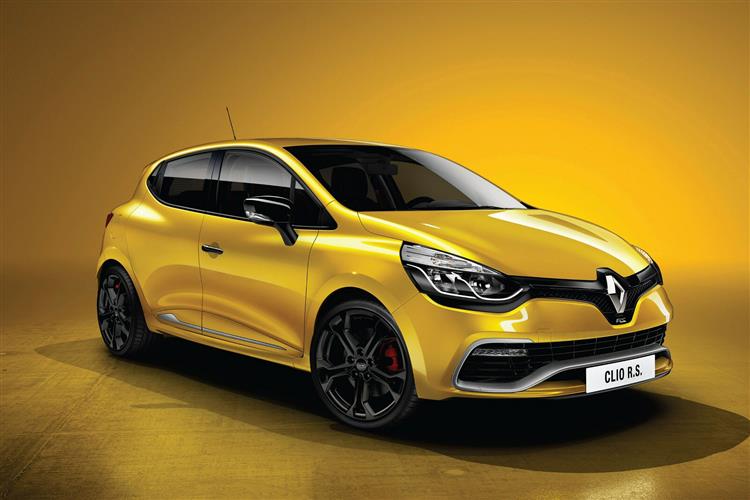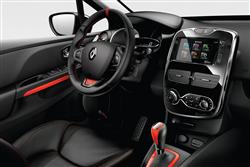CLIO PUP (some text hidden) --NONE--
By Jonathan Crouch
Introductionword count: 72
Back in 2013, the Renaultsport take on this Gallic brand's fourth generation Clio was a very different hot hatch to anything we'd seen from them before. A smaller but very powerful turbocharged engine. Twin clutch automatic transmission. Launch control. Rally-styling damping. Race-style telemetry. Nothing was held back. For its era, it all makes this a thoroughly modern shopping rocket. But one you'd want to own? That's what we're here to find out.
Modelsword count: 4
5-door hatchback 1.6 [petrol]
Historyword count: 437
Renault and motorsport have long been inseparable. A look back through history reveals how names like Alpine and Gordini have transformed the French brand's family models into track stars and rally replicas. Cars like the Renault 5 Gordini of 1976, the market's very first hot hatch and originator of a GTi market segment that in 2013 brought us a car as frantically fast and clever as this one, the Clio Renaultsport 200 Turbo. That last word is important. By 2013, it had been a long time since Renault had turned to turbocharging in its sportiest cars. Some hot hatch enthusiasts' earliest driving - and perhaps racing - memories may centre around the French brand's iconic 5 GT Turbo, a car which revitalised the small shopping rocket sector from its launch back in 1985 and continued to do so until the company switched to normally aspirated multivalve power in a succession of fast Clio models dating from the early Nineties. Following the turn of the century, these were all famously fettled by Renaultsport, a Dieppe division of this Gallic brand whose very name quickly became a byword for excellence in the hot hatch segment. This car though, was its biggest challenge yet. By 2013, hot hatch fans were expecting their cars to be leaner, more efficient and cleverer. The PlayStation generation simply didn't understand why the turbocharged engines and paddleshift transmissions they saw commonly used in every form of motorsport weren't routinely fitted to the affordable performance cars they wanted to drive. Properly satisfying this new class of customer meant ditching manual transmission, adding electronic driving aids and pensioning off the thirsty old 2.0-litre normally aspirated powerplant that'd thrilled Clio Renaultsport buyers since the turn of the century. In making all these changes, Renault risked alienating previous faithful Renaultsport Clio folk - and in many cases did. The expected pay-off though (which never really materialised) seemed potentially to lie in pleasing many more with the completely fresh approach taken by this car. For the 2013 model year, the hottest Clio you could buy was no longer state of the ark but state of the art with its 6-speed twin clutch automatic gearbox and smaller but equally powerful 1.6-litre turbo engine. In short, it had become a properly modern hot hatch. Plusher 'Lux Nav' trim arrived in 2015. And a rare track-focused Renaultsport 'Trophy' version of this car arrived in 2016, selling to the end of the production in 2018, which Renault finished off with a more road-orientated 'Special Edition' version of the standard Renaultsport Clio 200 EDC model. This RS Clio disappeared from the price lists in late-2018.
What You Getword count: 529
A Renaultsport Clio must look the part: this one does, all dramatic curves and muscular pumped-up wheel arches, creating a nicely hunkered down look that builds on the visual eye candy of stylist Laurens van den Acker's fourth generation Clio body shape. True, buyers are limited to the practicality of five doors, but that has less aesthetic impact here thanks to a coupe profile that conceals the rear door handles in the C-pillars. The front end design adds Renaultsport badging beneath the prominent diamond emblem, while LED daytime running lamps set into the lower part of the bumper offer up an individual lighting signature. Performance hallmarks include a deeper front bumper with Renaultsport's familiar F1-style blade. At the back, form and function blend seamlessly, the diffuser with its rectangular exhausts and the prominent rear lip spoiler for example, designed to work together just as they would in a single-seater race car to ensure the best possible aerodynamic performance. Inside, the driving position's high and purposeful. Not high and purposeful enough, it must be said, to offer decent over-the-shoulder vision through the restricted rear window (hence the desirability of the rear parking camera option) but front three quarter vision is fine and you're nicely positioned in front of a smartly designed dashboard that neatly combines both digital and analogue dials. You view it through a chunky three-spoke leather-trimmed wheel with its red-stitched straight-ahead top marker - a real driver's touch. Behind the wheel rim you'll find mounted the same anthracite gearshift paddles you'll find in a Nissan GT-R. Select the GT-R engine sound track from the R-Link multimedia system 'R-SOUND EFFECT' app and you could almost believe you were in Japan's premier supercar. Almost. The R-Link system's 7-inch colour touchscreen dominates the centre of the dash, trimmed around with a black gloss finish that's there to contrast with the liberal splashes of red supposed to lift the intentionally dark cabin. Some of it looks quite nice - the instrument needles, the red steering wheel stitching, the door panel beading and so on. And some of it's less successful - the finish around the disappointingly cheap-feeling auto gearstick for example. You've got to love the red seatbelts though, which as any fool knows, have got to be worth at least a second a lap. Overall, we'd say that while there are better quality-feeling cabins in this class from this era, there are few more interesting ones. On the back seat there's more space than that coupe-style profile leads you to expect - easily a match for (and arguably better than) frumpier-looking five-door rivals from the period like Volkswagen's Polo GTI or Skoda's Fabia vRS. Two adults will be fine on all but long-ish trips and three children quite happy over most likely journeys. There's decent room for their possessions too. Get over the rather high loading lip and you'll find a boot that at 300-litres, is one of the very largest in the class and about 15-20-litres bigger than most of the obvious competition. Push forward the 60/40 split-folding backrest and you can extend it to as much as 1,146-litres, which again is far more space than most rivals can offer.
To see the full road test text contact us on 0330 0020 227
Pictures (high res disabled)

.jpg)
|
.jpg)
|
.jpg)
| |||
.jpg)
|

|
Scoring (subset of scores)
Category: Sporting Cars
| Performance | |
| Handling | |
| Comfort | |
| Space | |
| Styling, Build, Value, Equipment, Depreciation, Handling, Insurance and Total scores are available with our full data feed. | |



